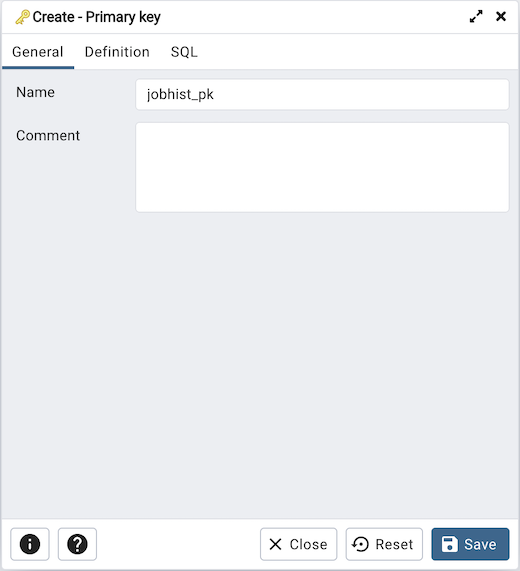Generating Primary Key Column Sql
Primary Key Generation Using Oracle's Sequence
Find Primary Key Sql
Apr 29, 2019 Hi Cathrine. Great hint/tip that I’m going to use more often to help me generate my queries. But, I want more. Is there a function or feature that can be used to produce the column or columns used in a table’s primary key? That would be very nice in helping to generate sorts and joins, both in t-sql and SSIS development. Thanks, Luther. APPLIES TO: SQL Server 2016 and later Azure SQL Database Azure Synapse Analytics (SQL DW) Parallel Data Warehouse. You can modify a primary key in SQL Server 2019 (15.x) by using SQL Server Management Studio or Transact-SQL. You can modify the primary key of a table by changing the column order, index name, clustered option, or fill factor. Jan 07, 2020 Auto increment columns widely used for auto-generating values for primary keys in Database tables.Most of the databases like SQL server etc have existing features to create auto increment columns. In Oracle 12c they introduced IDENTITY columns which allows users to create auto increment columns. Auto-increment allows a unique number to be generated automatically when a new record is inserted into a table. Often this is the primary key field that we would like to be created automatically every time a new record is inserted. Identical column wise except the table im inserting from does not have a primary key value. On insert I need to generate a primary key that is consecutive based on the table im inserting into. Also the table im inserting into does not have a identity column. Much appreciated.
Oracle provides the sequence utility to automatically generate unique primary keys. To use this utility to auto-generate primary keys for a CMP entity bean, you must create a sequence table and use the @AutomaticKeyGeneration annotation to point to this table.
In your Oracle database, you must create a sequence table that will create the primary keys, as shown in the following example:
This creates a sequences of primary key values, starting with 1, followed by 2, 3, and so forth. The sequence table in the example uses the default increment 1, but you can change this by specifying the increment keyword, such as increment by 3. When you do the latter, you must specify the exact same value in the cacheSize attribute of the @AutomaticKeyGeneration annotation:
If you have specified automatic table creation in the CMP bean's project settings, the sequence table will be created automatically when the entity bean is deployed. For more information, see @JarSettings Annotation. For more information on the definition of a CMP entity bean, see below.
Primary Key Generation Using SQL Server's IDENTITY
In SQL Server you can use the IDENTITY keyword to indicate that a primary-key needs to be auto-generated. The following example shows a common scenario where the first primary key value is 1, and the increment is 1:

In the CMP entity bean definition you need to specify SQLServer(2000) as the type of automatic key generator you are using. You can also provide a cache size:
If you have specified automatic table creation in the CMP bean's project settings, the sequence table will be created automatically when the entity bean is deployed. For more information, see @JarSettings Annotation. For more information on the definition of a CMP entity bean, see below.
Primary Key Generation Using a Named Sequence Table
Insert Primary Key Column Sql
A named sequence table is similar to the Oracle sequence functionality in that a dedicated table is used to generate primary keys. However, the named sequence table approach is vendor-neutral. To auto-generate primary keys this way, create a named sequence table using the two SQL statements shown in the example:
In the CMP entity bean definition you need to specify the named sequence table as the type of automatic key generator you are using. You can also provide a cache size:
If you have specified automatic table creation in the CMP bean's project settings, the sequence table will be created automatically when the entity bean is deployed. For more information, see @JarSettings Annotation. For more information on the definition of a CMP entity bean, see the next section.
Note. When you specify a cacheSize value for a named sequence table, a series of unique values are reserved for entity bean creation. When a new cache is necessary, a second series of unique values is reserved, under the assumption that the first series of unique values was entirely used. This guarantees that primary key values are always unique, although it leaves open the possibility that primary key values are not necessarily sequential. For instance, when the first series of values is 10...20, the second series of values is 21-30, even if not all values in the first series were actually used to create entity beans.
Defining the CMP Entity Bean
When defining a CMP entity bean that uses one of the primary key generators, you use the the @AutomaticKeyGeneration annotation to point to the name of the primary key generator table to obtain primary keys. Also, you must define a primary key field of type Integer or Long to set and get the auto-generated primary key. However, the ejbCreate method does not take a primary key value as an argument. Instead the EJB container adds the correct primary key to the entity bean record.
The following example shows what the entity bean might look like. Notice that the bean uses the named sequence option described above, and that ejbCreate method does not take a primary key:
ejbCreate method does not take a primary key: Generating Primary Key Column Sql Function
Related Topics